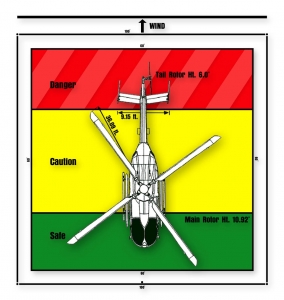LZ SAFETY REVIEW
Landing Zone Information:

Safety Tips:
» Identify obstructions/hazards (i.e., wires, trees, fences, etc.)
» Avoid slopes of > 10°
» Mark each corner with high visibility cones (orange is ideal)
» Do NOT use “scene tape” – It will be sucked up into the rotor blades
» NEVER approach the aircraft unless directed by the pilot and/or medical crew
Don’t rush…..THINK first!
Night Operations:
DON’T BE AFRAID TO ASK QUESTIONS!
Please follow these guidelines to establish a safe landing zone……
» Has a good sense of direction
» Familiar with the area
» Free from providing direct care to the patient(s)
Call STAT MedEvac Communications Center 1-800-633-STAT (7828) and provide the following:
» Radio frequency
» Number of aircraft needed
» Location/Landmarks
*Note: Utilize the local PSAP if applicable in your area
Guidelines to prepare a safe Landing Zone (LZ):
» Minimum 60 x 60 feet
» Ideal 100 x 100 feet < 10 degree slope
» Free from debris, obstruction, hazards (i.e., wires, fences, trees, loose objects)
» Mark each corner (i.e., independent lighting system, flares, cones, emergency vehicles)
Once contact has been made with the flight crew, provide helpful landmark information:
» Schools/Tennis courts
» Swimming pools
» Major road intersection
LZ Descriptions:
» Type of LZ (i.e., field, road, construction site)
» LZ surface (i.e., field, grass, concrete, gravel, dirt, snow covered)
» Boundaries of LZ (i.e., trees, houses, wires, picket fences, towers)
» Approach and departure pathways
Notify the flight crew when you:
» Hear the aircraft
» See the aircraft
» Direct the pilot to your location using the clock method
REMEMBER: WHEN USING THE CLOCK METHOD THE PILOT IS FACING 12 O’CLOCK!
Landing/Lift-off Safety Guidelines:
» Cover your eyes
» Never approach the aircraft unless directed by the pilot and/or medical crew
» Keep vehicles “at least” 50 feet away
» Keep crowds “at least” 100 feet away
» No objects or people in the middle of the LZ
» No flash cameras/white lights
» No running/smoking
